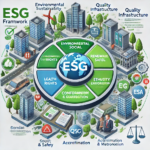ESG, Climate Finance, and the Role of Quality Infrastructure in Driving Sustainable Development
In the rapidly evolving global economy, Environmental, Social, and Governance (ESG) principles have emerged as a fundamental framework for responsible business conduct. ESG considerations are no longer optional; they are integral to risk management, corporate strategy, and sustainable investment. Climate finance, a key enabler of the global transition to a low-carbon economy, is driving large-scale investments in clean energy, sustainable agriculture, and resilient infrastructure. However, the effectiveness of ESG policies and climate finance is significantly influenced by the robustness of Quality Infrastructure (QI)—a system of policies, institutions, and services that ensure compliance with standards, certification, and accreditation. This article explores how ESG, climate finance, and QI interact to create resilient, sustainable, and economically viable systems.
ESG as a Driver of Corporate and Investment Strategies
ESG criteria serve as a strategic guide for companies and investors to manage environmental impact, social responsibility, and governance risks. Key components include:
- Environmental: Carbon footprint, resource efficiency, pollution control, biodiversity conservation.
- Social: Labor rights, community engagement, human capital development, supply chain integrity.
- Governance: Transparency, ethical business practices, regulatory compliance, and board diversity.
Regulatory bodies and financial institutions are increasingly embedding ESG requirements into corporate disclosures and investment decisions. ESG compliance not only enhances brand reputation but also provides companies with access to green financing, reduces regulatory risks, and improves operational efficiency.
The Role of Climate Finance in the Global Sustainability Agenda
Climate finance refers to financial flows—public and private—directed toward climate mitigation and adaptation projects. These include investments in:
- Renewable energy infrastructure (solar, wind, hydro, geothermal)
- Energy-efficient buildings and smart grids
- Sustainable transportation and electric mobility
- Carbon credit markets and nature-based solutions (reforestation, soil carbon sequestration)
Financial instruments such as green bonds, carbon credits, and sustainability-linked loans are shaping the landscape of climate finance. International institutions like the Green Climate Fund (GCF) and multilateral development banks play a pivotal role in mobilizing climate capital, particularly in developing economies.
Quality Infrastructure: The Missing Link in ESG and Climate Finance
Quality Infrastructure (QI) is essential for ensuring that climate finance and ESG initiatives achieve measurable, verifiable, and scalable impact. QI encompasses:
- Standardization: Development of internationally recognized environmental, social, and governance standards, such as ISO 14001 (Environmental Management) and ISO 26000 (Social Responsibility).
- Accreditation and Certification: Third-party verification to confirm adherence to ESG and sustainability criteria, boosting investor confidence.
- Metrology and Testing: Ensuring the accuracy of emissions data, energy efficiency ratings, and sustainability metrics through rigorous scientific measurement.
- Market Surveillance and Compliance: Regulatory oversight to prevent greenwashing and ensure alignment with global sustainability targets.
Bridging the Gap: Integrating ESG, Climate Finance, and QI
For ESG and climate finance to drive real change, a strong QI system must be in place. The integration of QI into climate finance mechanisms ensures that investments lead to tangible environmental and social benefits. Key recommendations include:
- Strengthening regulatory frameworks to mandate ESG disclosures and climate risk assessments.
- Developing local quality infrastructure to support emerging markets in meeting global sustainability standards.
- Encouraging public-private partnerships (PPPs) to scale up investments in green and climate-resilient projects.
- Enhancing capacity-building initiatives for SMEs and financial institutions to align with global best practices in ESG compliance.
Conclusion
As the world moves toward a sustainable future, the convergence of ESG, climate finance, and quality infrastructure is becoming increasingly critical. Companies, investors, and policymakers must recognize that without robust quality infrastructure, ESG commitments risk being superficial, and climate finance may fail to deliver meaningful results. By investing in strong QI systems, we can ensure that sustainability efforts are measurable, transparent, and effective, ultimately accelerating the transition to a greener, more resilient global economy.






